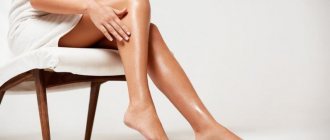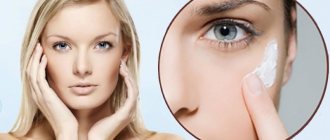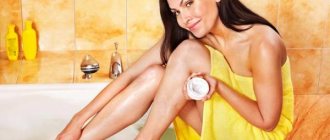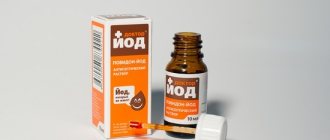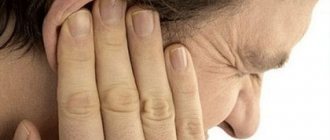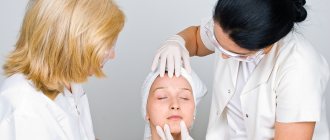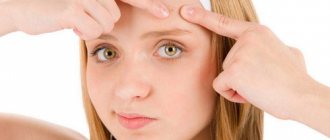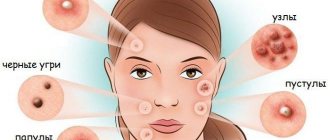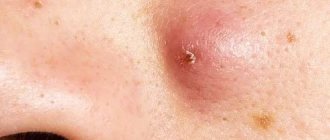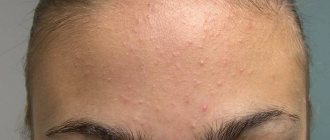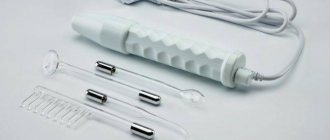Reasons for appearance
Shaving pimples can appear for a number of different reasons. Most often there are several of them. To effectively solve the problem, everything will have to be eliminated.
Health problems
Before looking for a way to get rid of acne on your beard after shaving, you should make sure that they occur precisely after this procedure. Perhaps the whole point is a problem with the internal organs; shaving, for its part, only further irritates and injures the inflamed skin. Rashes on the face can appear in the following pathological conditions of a man:
- allergic reactions, including to cosmetics, medications, pet hair;
- hormonal imbalance - can occur at any age, not only in teenagers;
- intestinal dysbiosis - the accumulation of toxins in the intestines always manifests itself as a rash on the face;
- dermatitis and other skin diseases;
- fungal infections;
- Nervous stress – a person’s psycho-emotional state is directly related to the work of all internal organs and systems; not only the skin suffers.
In this case, the rash is hidden under facial hair. When you start shaving, it is simply invisible to you, but the blade during shaving inevitably touches small abrasions, pimples and pustules, injuring them. Sweat, dirt, and sebum penetrate there. The result is red, inflamed pimples upon completion of the process.
How do you understand that you need a doctor’s help, and not just correction of your shaving procedure? Everything is very simple. If inflammation, irritation and redness do not go away even 2-3 days after the last shave, that is, in a state of complete rest, if the pimples become denser, increase in size, pus appears, if pain and itching intensify - it’s time to visit a good dermatologist. He will take a skin scraping, write out directions for general urine and blood tests, and, depending on the situation, recommend consultations with other specialists - an immunologist, an allergist, a gastroenterologist, an endocrinologist.
Dull blade
If you've made it a habit to shave with the same blade until it's as sharp as a plastic pizzeria knife, you shouldn't be surprised that you get pimples every now and then on your cheeks, chin, and especially your neck. Professionals recommend changing the blade after every second procedure, and if you use disposable machines, then use it only once and then throw it away.
This is not because they have a share with razor manufacturers. Even the best five blades of the most popular branded machine become dull with every pass and contact with skin and hairs. The more passes and contacts, the more the blade wears out. The second time you shave, you will never get the same quality as the first. This means you will have to spend at least one more time in the same place. That is, the risk of skin trauma, infection and acne increases. Add to this hairs, sebum, dirt, cosmetics, particles of which remain on the blade. A dull blade is the culprit of abrasions and a breeding ground for bacilli. Its place is in the trash can, keep it away from your face.
Low-quality cosmetics
A rash on the skin of the face can occur if you do everything correctly, use a clean and sharp razor, shave strictly according to the hair growth, but after shaving, apply an incorrectly selected or low-quality product to the skin. Secret observations and surveys prove: most men purchase cosmetics to care for their faces before, during and after shaving according to two principles:
- price and brand;
- smell.
Few people read what is written on the label, and it is completely in vain. So, dry skin needs softening and nourishing products with oils, but without alcohol. And for oily ones - light, moisturizing and refreshing, controlling the functioning of the sebaceous glands. If you choose the opposite, skin problems cannot be avoided.
It’s worth remembering: sometimes the cause of a rash on the face after shaving is fragrances, dyes and preservatives in shaving gel or aftershave. Unfortunately, it is not possible to visually determine whether the chosen shaving product is suitable for you or not. You'll have to find yours through trial and error.
Incorrect shaving technique
Surprisingly, about 80% of men shave incorrectly throughout their adult lives! Main mistakes and errors:
- movements against hair growth;
- multiple passes over one area;
- avoidance of aftershave products;
- dry shaving;
- rubbing your face with a towel after shaving.
We have separate detailed articles on how to properly shave with a safety razor or straight razor at home. We recommend it just in case.
How to get rid of acne on legs after shaving at home
Hair on the chin in women - causesNoticed a lot of unwanted hair on your chin? Before you start getting rid of them, try to find out their type and the reason for their growth. Our material today, dedicated to the problems of hirsutism and hypertrichosis in women, will help you with this.
Shaving irritation is localized redness, small red or white spots, rashes or actual inflamed pimples. The most sensitive areas are the bikini, armpits, face, and less commonly, legs and arms. To exclude it, it is necessary to prepare the skin for depilation correctly and ensure subsequent hydration.
Irritation is a peculiar and completely normal reaction of the skin to an irritant - a razor blade. It can appear from various types of depilation and epilation and is expressed mainly by the appearance of red dots, small pimples with or without itching.
Shaving with a razor is the most common method of depilation, that is, superficial hair removal without removing the follicle. Often, it is frequent use of a razor that leads to irritation, inflammation of areas on the skin and ingrown hairs. Yes, yes, all these phenomena are closely related to each other and there are a number of reasons why there is strong or weak irritation:
- Daily use of the machine. Frequent shaving thins the surface of the skin and literally irritates it. You may notice that the hair removal procedure can gradually become painful, and the skin takes on an unhealthy appearance - it becomes covered with a network of small pimples, red spots, and becomes dry and dull.
- Shaving with dull blades has a detrimental effect on the epidermis - they simply tear off hairs from the surface of the skin, rather than cutting them off (like sharp, sharpened, new analogues). Rarely changing the cassette in the machine, using a disposable razor for a long time or using dirty, rusty blades are all direct causes of irritation.
- Improper use of the razor. Hair removal is possible both according to its growth and against it. To make the home procedure safe, shave according to your height, this reduces the likelihood of accidentally cutting the epidermis and damaging it. Removing hair against the grain is more effective, but is not suitable for sensitive skin.
The floating head razor is ideal for depilation of various parts of the body and especially for the face and bikini area of women, knees and armpits. When shaving, it is especially important to use a clean blade and guide it over previously cleansed skin using a special composition - shaving cream or gel.
- Sensitive skin is also a reason, and you have to come to terms with it. Thin and sensitive dermis especially needs daily care - after taking a shower, apply a light moisturizer, and before depilation, use a mask - apply oil to the skin half an hour before taking a water procedure.
- Dry depilation with a razor often irritates the skin, so experts recommend carrying out the procedure in the bathroom: warm water expands the pores, moisturizes and softens the skin, and makes the blade literally glide across the surface.
- Insufficient skin hydration leads to red spots on the body after each shave.
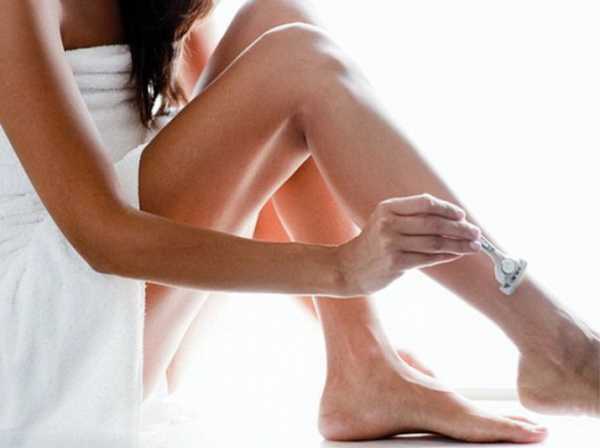
Skin irritation from using a razor is less common than from an epilator or “hot” methods of hair removal - waxing, sugar procedures. Most often it occurs due to razor abuse - daily use or due to hypersensitive skin. If this does not concern you, but irritation appears, the only possible reason is improper shaving: a dirty, dull blade, pressing the machine hard on the skin, processing one area more than 3 times.
Depending on the type and nature of the skin, the inflammation will go away within 10 minutes to 24 hours, or may not appear at all.
If irritation has become a frequent guest on the skin of a man or woman, you should stock up on moisturizing creams/ointments/lotions and apply them every time after the procedure. Then the irritation goes away almost instantly - after 10-20 minutes.
The irritation itself may go away after half an hour, an hour or several hours, depending on the skin reaction. Cosmetologists do not advise letting everything take its course. The skin experiences stress every time after contact with a razor blade, they say, it removes not only the hair, but also the stratum corneum of the skin. The latter should be removed first - this way the razor blade will not remove it and injure the epithelium, thereby reducing the risk of irritation.
Inflammation on the skin and disruption of the structure of the hair can lead to its ingrowth: the hair begins to grow not up, but down into the epidermis, inflammation appears - a voluminous and painful pimple. The main thing in this case is to start treatment on time. First you need to treat the inflamed area with any antiseptic - peroxide, alcohol, for example, pull out a hair and again treat the wound with a healing ointment. If the pimple is painful, you need to treat it with salicylic or zinc ointment, crushed aspirin tablet - they will relieve inflammation, swelling, dry the skin and prevent the appearance of a mark.
The best way to avoid irritation is to prevent it and:
- Every time after shaving, moisturize the skin with a light cream or gel (even a regular baby face cream or oil, a specialized composition for the body and face, will do);
- Use a clean razor - rinse it under water every time you finish shaving. If you cut yourself during it, additionally rinse the blades in a disinfectant liquid - peroxide, miramistin, alcohol;
- Before shaving, apply a special shaving gel or cream to the skin - this will allow the blade to glide gently over the surface of the skin and additionally prevent cuts. Shaving gel or foam envelops the hairs and gives the blade a better chance of grabbing them and cutting them clean;
- Shave in the shower (if it's your body) or while washing your face (if it's your face). Warm water will pre-steam the skin, wash away dead cells and prepare the skin for depilation;
- Use a light scrub or peeling before the hair removal procedure - it will remove the keratinized layer of cells and lift the hairs at the roots;
- Shave in the evening. Experts say that evening shaving has a better effect on the condition of the epidermis than morning shaving, since it allows the skin to rest, and the cream applied in the evening will work all night.

There are several features of proper shaving depending on gender. For example, men shave their faces almost every day, women shave their bikini area and armpits, and maybe even their legs. The skin of a man and a woman is certainly different, and it needs to be treated differently, so we will conditionally divide depilation into men's and women's.
Women's skin is usually thinner than men's. The need to use a razor depends on the woman: some shave every day, others every other day, and others even less often. The rate of hair growth varies, but on average it grows 0.5-1 cm per month. It's up to you to decide which razor to use - men's or women's. Manufacturers make them using the same technology; products can be distinguished by the number of blades, types of cassettes, head rotation angle and external design.
Experts recommend shaving the hair on your legs and thighs against their growth, that is, from the ankle or from the knee upward. This type of depilation is suitable for any type of skin and hair, but if the epidermis is too sensitive, you will have to remove hairs according to their growth, that is, move the razor from the knee to the ankle. Removing hair according to its growth is less effective - some of it remains on the skin and requires several passes - you will have to use a razor 2-3 times. But you should not treat one area more than 3 times - this may cause irritation or accidental cuts; It is better to repeat the procedure the next day. A preliminary scrub or light peeling based on acids will pre-cleanse the skin - remove the dead layer of cells; the use of abrasive particles after shaving (after 1-2 days) will prevent ingrown hairs.
Shaving your armpits involves moving the machine in different directions: up, down, right and left. They grow haphazardly in this area and it is important to capture and cut every one of them.
The bikini area will have to be treated in a combined way: start shaving the pubis according to the hair growth, that is, from its beginning down to the labia. Treat the most delicate area of the labia and intergluteal area in different directions for a “clean” removal.
Almost every day, men shave their faces - the cheek area, chin and neck. Manufacturers have released a lot of creams, gels, and pre- and post-shave lotions, and men should definitely use them.
Frequent depilation of the facial skin can lead to irritation, and it does not look the most attractive on the face. To prevent it, use any product before shaving: choose a consistency that is comfortable for you, since there is no consensus on what is better - gel or foam. Each time, use lotion or cream after hair removal - it will restore water balance, moisturize the skin, and prevent inflammation. For very thin, sensitive skin, choose cosmetics with aloe vera; for problematic skin, choose cosmetics with salicylic or any other acid (cosmetologists recommend using acidic products only in the autumn-winter period).
- Choose a razor with a floating head: it follows the lines of the face and prevents cuts;
- If you use a disposable model, then change it after each shave or when the blade begins to dull;
- You will have to change the cassette in the razor every 5-10 procedures, depending on the hardness of the hair - as soon as the blade begins to become dull and cut hairs worse, feel free to throw it away;
- Be sure to use foam, cream or gel before shaving; the first two additionally moisturize the skin, and the third can have a pleasant cooling effect;
- Do not press on the razor - high-quality or fresh blades cut hair at the slightest contact with it;
- Your razor is yours alone. Do not use other people’s machines and prohibit even the closest family member from using your own;
- Use the scrub on your face 2-3 times a week before using a razor. Abrasive particles will remove “dead” cells and provide better glide over the skin, preventing ingrown hairs.
If irritation after shaving has already appeared, this is not a reason to despair. Store-bought, pharmacy ointments and lotions, cold compresses and folk methods, which are quite reasonable, help relieve redness and a network of small rashes. First, let's talk about how irritation can manifest itself:
- Light redness. There is no need to treat it, it is enough to soothe the skin with tonic, alcohol-free lotion, hydrogen peroxide, a decoction of medicinal herbs and moisturize with cream (for children, for the body, ointment against ingrown hairs);
- Small spots or small pimples usually require moisturizing. If they are accompanied by itching, do not scratch them, just wipe with tonic or any other liquid solution with aloe vera, chamomile and apply a light moisturizer;
- Purulent pimples may appear 1-2-3 days after shaving. This is a consequence of clogged pores and ingrown hairs. This will require a whole range of measures from cleansing and disinfection to moisturizing and subsequent care.
Toners and lotions without alcohol help remove mild redness (it dries the skin very much, disrupts the lipid balance of the skin and is especially not recommended for use on the face and body with sensitive surfaces). Cold compresses will help relieve itching - put some ice in a bag and wrap it in a cloth or use a special bag of gel, pre-cooled in the freezer, apply to the skin and hold for 5-10 minutes until the itching and redness subsides. Be sure to disinfect the skin with peroxide, chamomile or calendula decoction, miramistin, chlorhexidine or any other pharmaceutical solution.
Boro Plus, Malavit, and Atovegin ointments help fight more serious manifestations - red or white pimples.
They help relieve irritation and have two consistencies - liquid and denser.
- It’s easy to prepare a decoction of chamomile, calendula, mint or other medicinal plant at home - brew a handful of dry powder in hot water, let it brew - the longer the better. You can brew chamomile or mint in a bag, leave for 20 minutes and cool. Homemade tonic is excellent at combating itching and skin irritation. Its remains can be poured into ice cube trays and frozen; the cubes will later be useful for skin care after depilation and simply for washing
- Aloe vera ointment is prepared as follows: grind the leaves of the plant using a blender or knife, mix the resulting pulp with vegetable oil. You can treat the irritated area with it immediately after the depilation procedure, and you will have to store the homemade ointment in the refrigerator.
- Lemon juice is suitable for relieving irritation from the surface of the hands and feet - wipe the skin with a cotton pad soaked in lemon juice.
Laundry soap is useful for treating severe inflammation and ingrown hairs - wash the body area with it, but do not forget to additionally moisturize the dermis with cream.
Treatment of long-term irritation should be entrusted to disinfectants from the pharmacy, such as chlorhexidine, miramistin. They should wipe areas on the body or face before applying ointment or cream. The next step is the use of cream, gel, ointment. Baby powder works well to relieve minor irritation and itching - just apply a little powder to the body.
“Bepanten” and “Panthenol” are considered excellent healing products - they moisturize the skin well and heal wounds, soothe and normalize the activity of skin cells, and are safe for teenagers, women and men of any age. Hormonal ointments are used by prescription and are not indicated for anyone who experiences irritation after shaving.
Inflamed areas of the body will have to be treated comprehensively: zinc ointment can be applied to pimples - it dries the skin well and disinfects it, absorbs excess moisture (pus) and lightens the affected areas, preventing the formation of age spots. Aspirin will help replace it - crush one tablet into powder, add a few drops of clean water and apply to the inflamed area on the body. Leave the mixture for 5-10 minutes and remove with a cotton pad. Aspirin copes excellently with itching, abscesses, its active ingredients have a disinfecting effect, relieve redness, pain and any discomfort.
Salicylic acid in a tonic or lotion helps relieve irritation - the component dries the skin, kills bacteria and infections and any irritants.
Irritation in the bikini area worries a large number of women - this is openly discussed on forums. Girls prefer to remove hair from intimate areas every day or every other day, and this becomes a serious reason for unpleasant irritation, which is accompanied by itching and an unsightly appearance, leading to ingrown hairs and the appearance of spots.
Forum members advise putting down the razor and turning to hair removal - with wax or sugar. If it is contraindicated, then, women say, you need to stock up on “bepanten” and other ointments, as an option – aloe and chamomile, and treat the depilated areas immediately after the procedure.
Men, like no one else, know about irritation on the face. Redness, small rashes or contrasting white dots on the face are the usual arsenal, much worse are pustules, itching, ingrown hairs. However, men are more knowledgeable in depilation - almost all of them use foam or gel before shaving and cream after. This method is the only sure way to maintain an attractive appearance and self-confidence.
Users of razors especially praise folk remedies - chamomile, mint and even birch leaves (pre-brewed) cope well with itching and are safe for health, but they do not recommend using ointments and gels with hormones on their own, only for serious inflammations and with the permission of a doctor.
The next video contains advice from a dermatologist on how to get rid of irritation after shaving.
Shaving is one of the most common ways to combat unwanted body hair due to the fact that it is quick and cheap. But there are some negative aspects here too. For example, after shaving, pimples may appear, which do not decorate at all, but add unnecessary worries. Therefore, it is important to find out why they appear and what is the best thing to do about them.
Anyone who has ever used a razor has experienced skin irritation, when it turns red, itches and various inflamed elements appear. This is due to three reasons:
- ingrown hairs;
- infection;
- allergy.
Treat yourself! The story of how Ksyu got rid of hair without pain. Read more >>
The first reason is the most common. This is why pimples pop up after epilation with wax, an electric epilator and after using a razor. The hair loses the path along which it usually grows and begins to move in different directions that are unusual for it.
Hair can grow sideways, deep inside the skin, or curl into a ball in one place. All this not only looks unsightly, but can also become inflamed at any time, which is what most often happens. Thus, small and large pimples appear, which in particularly advanced cases can merge into large inflamed lesions.
The infection can get into micro-wounds that form during shaving. It lurks on razor blades, especially dull ones, on the hands and skin. If you do not follow basic hygiene rules, this can easily result in severe irritation of an infectious nature.
Allergies can occur to aftershave and aftershave products, so choose them carefully if your skin is too sensitive. It is also advisable to give preference to clothes and underwear made from natural fabrics that will not provoke allergic reactions and will allow the skin to breathe.
Each reason has its own triggers that you need to know about in order to protect yourself as much as possible. If you don’t yet know why acne appears after shaving, then we suggest you familiarize yourself with the likely factors.
- Unprepared skin. Before shaving, be sure to keep your skin clean. It is advisable to steam it. This will make it easier for the razor to cut the hairs.
- Dull razor. Not only do microbes accumulate in its microcracks, but it also scratches the skin, so the blade always needs to be changed on time. If it does not cut all the hairs the first time, then this is the first sign that it has become dull.
- Shave dry or use soap instead of special products. When shaving dry skin, the razor literally cuts off its top layer. After a short time, severe redness appears and scratches can be seen, which can easily become infected. Soap dries out the skin, so it is better to use special shaving gels or creams.
- Although shaving against the hair growth is cleaner, it most likely provokes ingrown hairs, and, therefore, the appearance of itchy pimples. If you know for sure that you may have such a problem, then you need to accustom yourself to shaving according to hair growth.
Knowing the main reason why pimples appear after hair removal or shaving, you can easily derive rules that should be followed in order to avoid such a result. But what to do if terrible itching and inflammation still appear? First of all, you need to relieve inflammation. For this:
- Stop shaving until the pimples are completely gone.
- Apply soothing and antiseptic products to acne. The most effective are pharmaceutical ointments containing zinc. You can also make an infusion of chamomile, calendula or sage. Tea tree oil helps with acne, dilute it with water and wipe the problem areas with a cotton swab moistened several times a day.
- If the pimple is ripe, you can gently squeeze it out. Often the hair that causes the inflammation comes out along with the pus. The procedure must be performed with clean hands. Lubricate the pimple itself with alcohol before and after the procedure.
When the pimples dry out, move on to peeling, which will remove the ingrown hairs before they have time to cause new inflammation. However, if there are even single pimples, then this should not be done.
Shaving, unfortunately, is not for everyone. Sometimes a person suffers so much from various kinds of irritations that the only advice for him is to change the method of hair removal. But before that, make sure you are doing everything correctly while shaving. Sometimes one small mistake leads to such sad consequences as acne and it is enough to correct it for the skin to become smooth and clear.
Have you ever tried to get rid of body hair? Judging by the fact that you are reading these lines, the effect was short, and the growing hedgehog did not please you.
Have you already thought about painful or costly procedures? This is understandable, because hairiness is both discomfort and the inability to wear short sleeveless dresses.
But perhaps not everything is so sad? Follow the link and find out how Ksyu got rid of her hair and is happy with smooth and soft skin.
Irritation after shaving in the bikini area How to easily get rid of acne on your legs using a coffee scrub How to get rid of red spots and scars after acne Fat under the arm: a problem or not? Sea buckthorn face mask

Honey-lemon face mask
source
What do beautiful legs mean to a girl? This is confidence in yourself and your beauty! Especially for those who are used to wearing short skirts and for whom their legs are their main weapon. What if this beauty began to be spoiled by pimples and other unpleasant rashes? This is the end? Read our article carefully.
Acne and other inflammatory processes, without hesitation, can appear on absolutely any part of the body. And, unfortunately, legs are no exception. We list the main reasons for the appearance of a rash in this area:
- Wrong choice of clothes. Most often, girls face the problem of rashes after wearing tights. With the arrival of cold weather, our immune system becomes weaker, and if we wear thick, warm clothes, we can get into trouble in the form of irritation and rashes on our legs. Especially if the material of the clothing worn that comes into contact with the skin is not natural, but synthetic.
It is also worth noting the fact that we often dress “not for the weather.” High boots and warm multi-layered clothes do not allow the skin to “breathe”. In particular, this applies to girls working indoors in such attire. The sebaceous glands will produce more oil throughout the day, and irritation is sure to occur.
- Hormonal imbalance. For example, postpartum health may deteriorate slightly due to a sharp change in hormone levels. During such a period, rashes may also occur.
- Avitaminosis. The lack of vitamins necessary for our health can manifest itself in any way. The main source of vitamins is plant foods, which we consume in sufficient quantities from summer to mid-autumn. Therefore, starting from the end of winter, many people suffer from a lack of essential vitamins. And as a result, pimples appear.
- Allergic reaction. It is worth saying here that allergies can occur due to contact with household chemicals: shower gel, washing powder (poorly rinsed clothes after washing), body lotion, creams, etc. You can also note allergies to certain medications, clothing materials (wool, synthetics) and much more.
Pimples on the legs after shaving are also quite a popular situation. Here rashes from mechanical damage appear due, for example, to a dull machine.
- Ingrown hairs, which then turn into purulent subcutaneous pimples. So, after shaving with a machine, many girls face not only the problem of an allergic reaction to the procedure, but also the appearance of ingrown hairs.
- Hypothermia. This applies, first of all, to the cold season, when nylon tights do not warm at all, the skin becomes overcooled and unpleasant pimples appear.
It is worth paying attention to the fact that the rashes can be different: pinpoint pimples, small clusters of water acne, extensive itchy rash, etc. And we must be aware that there are diseases that need to be treated as quickly as possible. If you understand the possible cause of inflammation on your legs, try to fight them yourself using folk or pharmacy remedies. Otherwise, we strongly recommend that you consult a dermatologist, who will immediately determine the source of the problem and offer high-quality and effective treatment. Don't play with your health!
To prevent acne on your legs from becoming the main problem that occupies all your thoughts, we suggest following some rules to keep the skin of your legs beautiful and healthy:
- Wear clothes made from natural materials. Cotton should be your best friend.
- Pay attention to the cosmetic products you use: tonics, creams, lotions, etc. If there is even the slightest allergic reaction after using them, change the product to a hypoallergenic one.
- Use chlorine-free household chemicals whenever possible. Also remember that public pool water also contains chlorine.
- Dry the rashes in the sun. It is possible in a solarium, but it is impossible to replace a natural solar healer.
- Maintain good hygiene. Wash problem areas of your feet thoroughly, but remember that it is not recommended to wash with force with a washcloth, damaging the dermis. Rubbing in the hope of tearing off small pimples is not our method, it will only make things worse!
- Take vitamin A, essential for skin. You shouldn’t forget about other vitamins (B, C and many others).
- Watch what you eat. Include more vegetables and fruits in your diet. Eliminate spicy, salty, fatty, sweet foods.
- Do not squeeze out any large or small pimples - after this there will be many more of them.
- When shaving your legs with a machine, it is better to use shaving gel rather than foam, do not apply products with aggressive components (for example, containing menthol) before and after this procedure, do not wash your legs with a washcloth after the procedure, and after finishing, moisturize the skin with cream (preferably for children). Then you won’t know about acne on your legs after hair removal.
A good alternative to machines is laser hair removal, you can also try wax.
Some experts argue that based on the location of acne, we can talk about the specific reason for its appearance. Of course, this doesn't work 100%. But let's provide some data:
- Inner thigh: most often inflammation occurs due to friction, especially in obese people.
- Foot (where there are no sebaceous glands): a rash in this area may indicate an allergic reaction to soap or household chemicals.
- Along the entire length of the legs: consequences of hypothermia or hair removal.
It is also worth paying attention to the type of pimple:
- Purulent - talk about infectious processes in the body.
- Subcutaneous - considered the most dangerous, they speak of a hereditary pathology.
- Water - a possible allergic reaction to taking any antibiotics or other medications.
- Dry - a sign of hypothermia.
The main rule in the treatment of any disease is systematicity. Procedures must be performed daily. Only then will the result not be long in coming. Traditional medicine offers the following solutions to our problem:
- Wipe your feet with salicylic acid, chloramphenicol solution 5% or a decoction of medicinal herbs (chamomile, calendula, etc.). This will dry out inflammation, removing oily skin. Perform the procedure daily 2 times a day (morning and evening) after taking a shower.
- Mix glycerin and acetylsalicylic acid (powder) in a 1:1 ratio. Apply this mixture to the inflamed areas for 20 minutes.
- For ingrown hairs, you can use a scrub, for which you can add your choice of salt, sugar, crushed coffee beans or peach, apricot, etc. seeds to your usual shower gel.
- Using a cotton swab, you can spot-treat the pimple with iodine solution, being careful not to get it on the healthy skin around it.
- Aloe juice. To do this, the aloe leaf must first be placed in a dark, cool place (for example, a refrigerator) for several days, then cut lengthwise and the pulp applied to the inflammatory areas for a couple of hours. The procedure can be repeated daily.
Our next piece of advice would be to take baths with medicinal herbs. So, the herb must be brewed firmly in a container, then added to a warm bath (you can use herbal tincture). And if you add a little honey or tea tree essential oil, success is simply guaranteed.
- With chamomile: relieves inflammation, disinfects, softens the skin.
- With a series: has an antimicrobial effect, relieves inflammation, prevents the formation of new acne. The herb is indispensable for purulent inflammations.
- With calendula: relieves inflammation, perfectly regenerates the skin.
- With sage: soothes, relieves itching.
- With oak bark: relieves irritation and inflammation, relieves pain, protects against germs.
These herbs can also be used when applying lotions.
We also recommend taking the following baths:
- Salt salts: add salt (preferably sea salt) to a warm bath/basin. After the procedure, do not rinse, but blot with a towel. If after a bath you feel a strong sensation, switch to herbs.
- Sunbathing. Yes Yes! It's sunny. If this is not possible, visit a solarium.
- After taking a shower, wipe your feet with wheat germ oil (available at the pharmacy);
- Make a mask: mix well 2 tsp. lemon juice and beaten egg white. The mask is applied to problem areas for 20 minutes.
In the modern world, pharmaceutical companies offer us a huge selection of drugs for almost any disease. You can consult with a pharmacist and buy medicine “according to your wallet,” you can talk about this topic with your friends or find answers on websites, or it’s better to contact a professional – a dermatologist. After all, the problem may turn out to be much more serious: thyroid disease, infection, malfunction of a certain internal organ, etc. One way or another, according to reviews of people who have encountered a similar problem of pimples on their legs, we list the most popular remedies:
- Skinoren cream is based on azelaic acid and has anti-inflammatory and antibacterial properties.
- Radevit ointment – has anti-inflammatory, softening, moisturizing properties, enhances the protective function of the skin.
- Skin cap cream – has antibacterial, antifungal, anti-inflammatory properties, contains zinc.
- Eplan cream - has wound-healing, regenerating, bactericidal, analgesic properties. Prevents infection, accelerates the healing of wounds and pustular skin lesions.
If you find any inflammatory processes on your legs, do not hide them under long skirts, pants, etc. Take action! After all, any rash on the skin is a cry for help from our body. Listen to him. And remember: a healthy body is the key to beauty and harmony in life!
Amina Pirmanova / article author
source
Add a comment Cancel reply
- Copyright holders
- Privacy Policy
Diseases of the nose and their treatment © 2020 All rights reserved © 2020. Attention! The information published on the site is for informational purposes only and does not constitute a recommendation for use. Be sure to consult with your doctor! The Materials may contain information intended for users over 18 years of age. 18+
Specific causes of acne after shaving
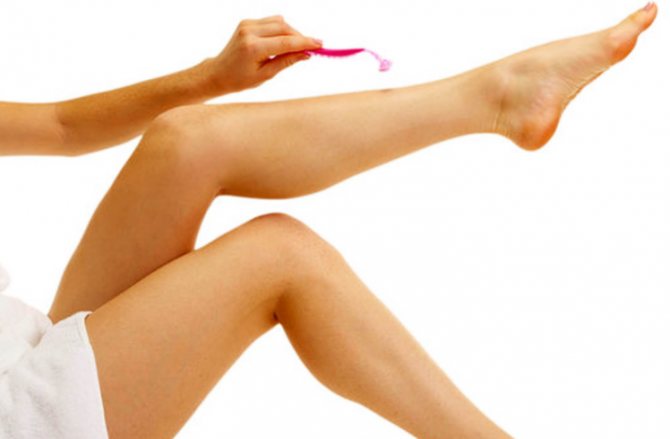
The most common factor is mechanical damage to the top layer of skin, which we have already discussed. But the list of additional possible reasons is long:
- Using inappropriate soaps and cosmetics. Shaving foams and aftershave lotions seem to be completely harmless substances. But you need to choose them carefully, based on your skin type. Otherwise, there is a high probability of acne appearing after shaving. This is logical, because the skin is damaged, and substances that are incompatible with your body penetrate inside. Naturally, the dermis will begin to signal a violation.
- Wrong type of razor. The developers of both electrical devices and disposable machines claim that their products are absolutely safe. High-quality materials are used, parts are positioned correctly, and so on. But practice shows that the wrong type of razor can still cause a rash after shaving in a person. If you have been using one type for a long time, and problems appear after each procedure, try simply changing the tool.
- Incorrect shaving procedure. Depending on your skin type, there are entire techniques that will help you avoid possible problems. So, if you have delicate sensitive skin, you need to razor slowly, with minimal pressure. It is not recommended to apply the same area of skin twice in a row. In the case of the dry type, the pace accelerates slightly and the pressure increases. Stick to these principles.
- Blades unsuitable for shaving. Carefully monitor the condition of your instrument. Change the components regularly, clean the razor and renew it. By the way, skin irritation after shaving occurs most often in people who use disposable razors for several weeks. Even if the blades seem sharp and the razor looks brand new, never deviate from the instructions. Use such machines exactly as many times as stated by the manufacturer.
- Incorrect use of shaving gels and foams. First of all, be careful about your choice. Remember that the product must suit your skin type. Study the composition and make sure that the selected gel or foam is not capable of causing an allergic reaction. Also keep in mind that you need to apply products to your skin correctly. Rub a small amount of gel in circular massage movements evenly over only those areas that you are going to shave. Rinse off the product using the same principle.
- Lack of aftershave and aftershave products. This is a cardinal mistake. Dry shaving is almost guaranteed to cause breakouts. The cover is broken much more. So, even if you don't feel any change, irritation will begin to appear over time.
Causes
Men use a machine and an electric razor to remove hair from the surface of the skin. Women, in addition to machines, use depilation, hair removal and other methods. However, the problem of acne after shaving hair affects both men and women. The skin on the face, armpits and groin area is very thin and easily irritated. So why do acne appear after shaving? There are a number of factors that explain this reason:
- Allergy to cosmetics for or after shaving. The allergen must be excluded from use, otherwise rashes and pimples will appear in the same place constantly. It is better to choose a product for sensitive skin.
- Mechanical damage. Perhaps there were already areas of inflammation on the skin that were injured during the shaving process. Microbes enter the microtrauma and inflammation occurs.
- Unsuitable razor. This happens when a familiar tool changes. The skin gets used to a certain mechanical effect, and switching from an electric razor to a razor or vice versa can cause acne.
- Failure to comply with hygiene standards. Hands must be clean. Shaving accessories must be individual. Personal hygiene items should not be given to strangers. After shaving, the razor should be rinsed thoroughly.
- Using dull blades. This often happens when you use a disposable machine repeatedly. A dull blade does not cut hair the first time, and you have to run it over the skin several times. Which again leads to damage to the epidermis.
- Incorrect shaving product. If you shave, foam or gel should make the razor glide easier, otherwise wounds will appear on the skin. The product should be selected for your skin type.
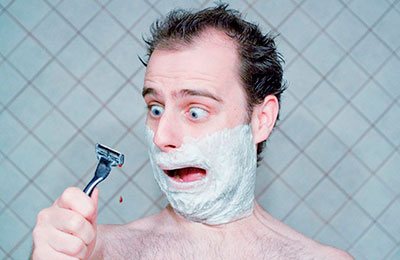
Causes of acne after shaving
Pimples, like other signs (itching, irritation, purulent accumulations, acne, rash), appear in the genital area for many reasons. In most cases, a woman can guess what triggered the appearance of a disorder in the intimate organs. However, this approach contains a high risk of error, in which the woman will take the wrong measures to eliminate the pathology.
To prevent such developments, doctors recommend that when the first signs of a disorder appear, consult a qualified dermatologist. Experienced experts name the following reasons that cause acne in the bikini area:
- Using a razor with dull blades, a poorly sharpened metal surface, in contact with sensitive skin, damages it and leads not to cutting, but to pulling out hair. Repeatedly running a blade over one area of the skin leads to irritation, causes hyperemia and causes the appearance of local reactions of the immune system in the form of acne.
- Incorrect shaving technique in which the razor moves against the direction of hair growth, rather than at a slight angle or in the direction of growth.
- The use of low-quality skin care products, in which the partially injured layer of the dermis is subjected to additional treatment with lotion, cream or gel containing preservatives, fragrances and other chemicals. In this case, as an individual reaction of the body to the components of the product used, an allergic rash in the form of small pimples may appear.
- A red, watery rash is one of the signs of damage to the body by the herpes virus and requires immediate treatment, since after maturation and destruction, ulcers appear in their place.
- Infection and inflammation of the sebaceous glands, caused by pathogenic microflora entering the damaged area of the skin, provokes the appearance of red acne with a dense texture.
- Insufficient personal hygiene in the genital area leads to the appearance of blackheads and white pimples.
- Changes in hormonal levels, a deficiency of some type of biologically active substances can also cause a rash.
- Carrying out the procedure for highly sensitive skin can lead to irritation and rash.
To correctly determine the cause of the pathology, timely relief of symptoms and treatment of the disorder, after detecting the first signs of deviation, you should consult a dermatologist.
Why do acne appear after shaving?
Irritation is associated with itching, the appearance of unsightly spots, pimples, and small rashes. All skin defects cause discomfort, reduce self-esteem, which affects the quality of life. The unpleasant consequences of poor shaving lead to rapid aging of the skin and sometimes cause tissue atrophy.
There can be several factors causing irritation on the skin of the face:
- Shaving frequently. During the procedure, along with the hair, the top layer of the epidermis is partially removed, causing the dermis to become sensitive and easily vulnerable.
- The capabilities of the shaving device have been exhausted. This applies to both reusable machines and disposable devices that are not designed for repeated use.
- When shaving, a machine with an excessively sharp blade is used.
- Improper operation and storage of shaving accessories (hair residues and particles of epidermis on the machine in the absence of proper disinfection are a favorable environment for the growth of bacteria, a guarantee of subsequent inflammation).
- The skin is affected by ulcers and pimples. Cutting off skin formations leads to the spread of pathogenic organisms and their metabolic products over the entire surface, which leads to the emergence of multiple foci of inflammation.
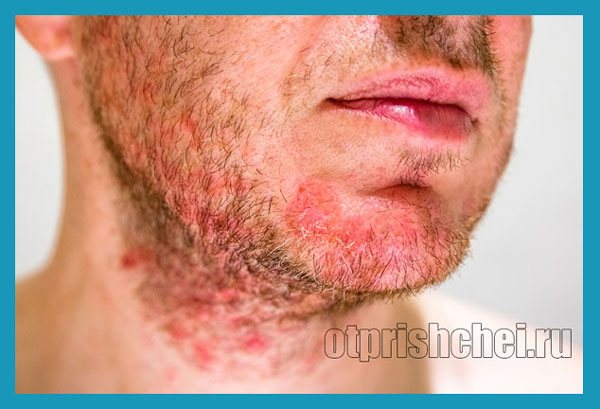
- If you have allergic rashes or seborrheic dermatitis on the cheeks, chin, neck, it is better to refrain from shaving. In such situations, the skin is already very irritated. And shaving is irritating. In addition, these actions will increase the spread of inflammation.
- When caring for your face, you use cosmetics that contain irritating compounds. They dry out the skin, such as ethyl alcohol.
- Avoid using facial moisturizers after shaving.
- A sharp change in temperature after the procedure.
- Irritation can be caused by incorrectly selected hygiene and cosmetic preparations containing components that cause individual intolerance. If the procedure is poorly prepared, then the presence of dust with increased activity of the sebaceous glands leads to clogging of the skin pores. In this case, inappropriate cosmetics and perfumes aggravate the situation and contribute to the development of inflammatory processes.
- Irritation can cause pseudofolliculitis. Impaired hair growth, caused by frequent hair removal, leads to the formation of tubercles or swellings in place of the hair follicles. Hair growing in them leads to redness and itching. Sometimes these phenomena are accompanied by purulent processes.
- Intensive hair growth in some cases requires shaving several times a day, which reduces the recovery time of the epidermis. Repeated manipulations on the same place to obtain high smoothness, incorrect direction of machine movements also lead to irritation and pain.
Use of folk remedies
Or you can do without cream altogether. Aloe grows in almost every home. You can use the leaves of this plant, or rather their juice. Before squeezing the juice, be sure to rinse the leaf under running water. Then, either simply squeeze out the juice, or three leaves on a fine grater and using gauze, separate the pulp from the juice. Apply the resulting juice to the area where acne and shaving rashes appear.
An alternative to aloe is avocado. This fruit also has a soothing effect on the skin. In this case, there is no need to extract juice. We cut the avocado into pieces, the size of which corresponds to the size of the area of inflammation, and apply the fruit to the inflamed area of the skin. In addition to the fact that avocado will help get rid of acne caused by shaving, it will saturate the skin with healthy vitamins.
It is worth noting that aloe juice can be an excellent alternative to aftershave lotion. It is advisable to use it for the neck and chin area. In addition, it will cost much less than the most budget lotion. An alternative to aloe juice in this case can be chamomile tincture. It can be quickly prepared at home. These simple and cheap remedies will not only help remove rashes on the neck or any other area of the body, but will also prevent their occurrence.
Methods for dealing with irritation
It is better to prevent irritation than to treat it later.
By following simple rules, you can avoid the occurrence of a rash:
- You only need to remove well-moisturized hair; when it becomes soft, it will be much easier to shave and the skin will not be damaged. It is recommended to shave your hair after a bath or shower if you are using a razor. When using an electric razor, on the contrary, the hair should be dry.
- Before removing hair the day before, you need to thoroughly scrub the skin to get rid of the stratum corneum and ingrown hairs.
- It is recommended to purchase a special cream; it will prevent irritation.
Important ! It is strictly forbidden to shave on dry skin without using foam or soap base. If such manipulations are carried out frequently, then the occurrence of a rash and severe irritation cannot be avoided, but the worst thing is that the risk of skin cancer increases several times
You can watch the video for tips on proper skin care for men.
If you still cannot avoid irritation or rash, then you need to understand the methods of dealing with them. They may differ for each area, so let’s look at how to remove pimples after shaving in the bikini area, on the face, and on the legs.
On the face and neck
In order to cure a rash on the face and neck, as well as, you can use the following methods:
- Make a decoction of parsley leaves or hop cones. Per liter of water, 15-20 g of fresh leaves or cones, boil and cool. Use as compresses.
- Vitamins A and E work well. For this product, you need to purchase vitamins in an ampoule at the pharmacy and mix them with almond or peach oil. Apply to problem areas of the skin as a lotion.
- Products that are used after hair removal, containing aloe and chamomile, are good at disinfecting, soothing and healing the skin.
On foot
If acne appears after shaving your legs, you should:
- Use bactericidal agents that contain cortisone.
- You can make a homemade cream that will help restore your skin after hair removal. For this purpose, 2 aspirin tablets. must be mixed with glycerin to form a medium-thick mass. This product should be applied to inflamed areas.
- Calendula products after hair removal are a great option for treating rashes.
Useful video with tips for girls.
Armpit areas
Let's look at how to get rid of acne after shaving in the armpit area.
Chamomile and mint decoction is considered an effective remedy.
. To prepare it, you need to take a glass of water and half a tablespoon of herbs, bring to a boil and cook over low heat for 2 minutes. Then leave for 1 hour, and you can apply to the area.
Hydrogen peroxide and alcohol are also effective. Areas of skin that have been subjected to hair removal must be treated with these products.
In intimate places
Pimples on the pubis after shaving are a fairly common problem. To combat irritation in intimate places, you can use aspirin tablets
. To do this, you need to crush the tablets and mix them with a small amount of water to form a paste.
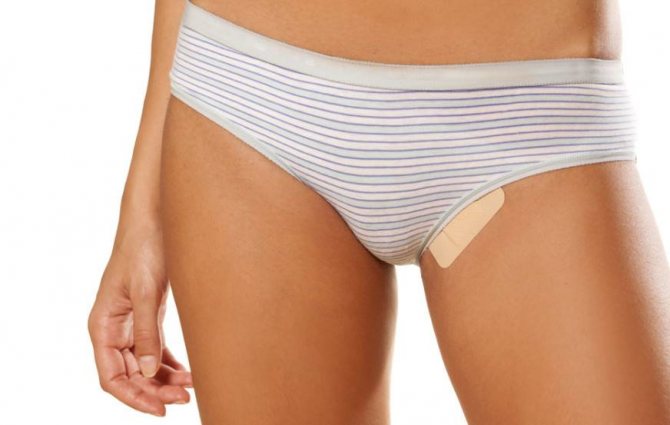
This remedy should prevent irritation. After the procedure, it is necessary to treat the shaving area with peroxide.
Aloe ointment is also good for relieving rashes.
Ways to prevent acne
Preventing the formation of pimples after shaving is much easier than subsequently treating severe skin inflammation. There will be few basic rules:
- shaving with a machine is done only after moisturizing the skin and hair (use an electric razor with completely dry hair);
- hard bristles must be softened (with warm water and foam);
- 1-2 days before shaving, it won’t hurt to go over the regrown hairs with a scrub (the abrasive particles will help “lift” small hairs, remove dead skin cells of the upper layer of skin, and make it easier to remove hair with a razor);
- Particular attention must be paid to the selection of special high-quality cosmetics for and after shaving (before using a new gel, you can do a skin sensitivity test).
Did you know that some experts advise women to use a man’s machine? There is an opinion that it removes small and fine hairs better than women's razors.
NOTE!
To quickly get rid of blackheads, acne and pimples, as well as to rejuvenate your facial skin, we recommend that you familiarize yourself with this effective remedy .
Find out more...
How to shave your hair correctly? It is strictly forbidden to repeatedly use the blade over the same place. The machine is moved with smooth movements along the hair growth line. But what about the recommendations to shave stubble against growth? Unfortunately, this causes ingrown hairs and skin inflammation.
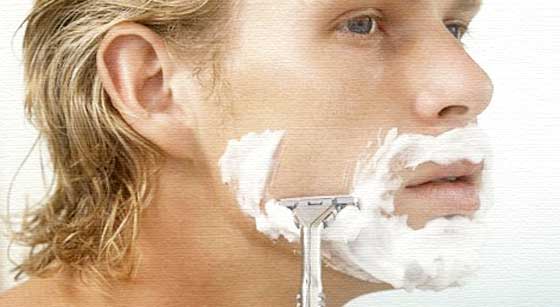
Lightly stretching the skin while shaving will help remove short hairs. For the bikini area, women should have a separate, reusable machine with multiple blades.
Methods for dealing with irritation
If you couldn't prevent the rash from appearing, it's time to start fighting it. Small pimples and red spots significantly worsen the appearance and may be itchy or even painful. That is why simply waiting for them to go away on their own is not the best option. After all, they may not disappear for more than a day, and then appear again after the next time.
First of all, after depilation or if a rash appears, you need to apply a cream for sensitive skin to the problem area. It is advisable that it contains aloe, this component has a strong calming effect. A witch hazel-based lotion with minimal alcohol content is suitable. These products perfectly soften the epidermis, make the skin smooth to the touch, and eliminate itching and red spots.
If you couldn’t purchase a product with aloe extract or it doesn’t have a strong enough effect, you can use the plant itself:
- tear off a small piece of leaf;
- rinse it under cold water to remove dust and dirt;
- squeeze the juice out of it;
- apply it to the inflamed area.
You can add avocado slices. It quickly relieves irritation and saturates the epidermis with vitamins. A good way to combat rashes would be an ointment with calendula extract and almond oil, which can also be used for acne that did not appear due to depilation. For some, baby powders and creams for irritation and diaper rash (Bepanten, Desitin, Sudocrem) help well.
When should you see a doctor?
In rare cases, it happens that the bumps and red spots that appear do not go away within 2-3 days. If the temperature persists, the irritated areas are swollen and purulent inflammation occurs, then you should immediately visit a doctor. These symptoms may indicate an infection. You may need to undergo a course of treatment to prevent this situation from happening again.
In other situations, the rash is not considered dangerous and can be treated at home. The main thing is to adhere to the rules described above in order to prevent or quickly eliminate a problem that has already arisen.
(Votes: 4, rating: 4.00 out of 5)
Types of rash
To understand how to care for problem skin of the chin and what medications and folk remedies will help restore the appearance of the face, you need to be able to differentiate pathological changes on the skin.
Minor rash
It is this that falls under the classification of “oral dermatitis”. Doctors say that this phenomenon indicates a weakened immune system or the use of low-quality decorative and caring cosmetics.

If the small rash has a watery structure, then the cause of its appearance may be an allergy to food or drugs
It is important to find out the true irritant so that subsequent treatment does not cause more harm
Most often, such rashes on the chin disappear as soon as the allergen disappears from a woman’s life, she begins to competently use good cosmetics and take vitamin and mineral complexes to strengthen the immune system.
Red rash
Most often it appears as an allergy to some external/internal irritant or as a result of disruption of the endocrine system. You can differentiate these two reasons yourself: dense red nodules on the chin are very itchy in the first case, but become inflamed and increase in size in the second.
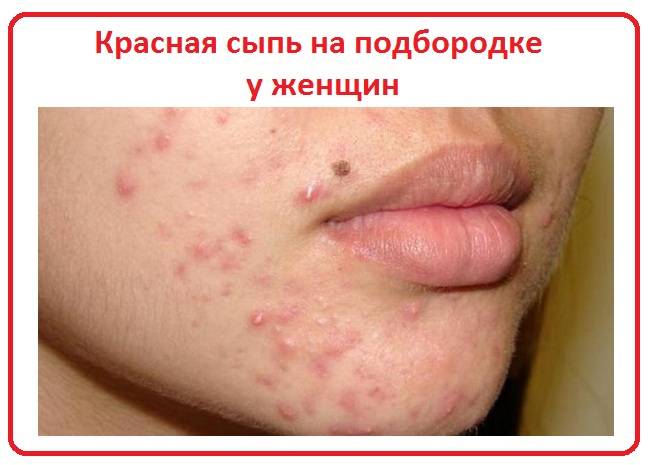
Another way to clarify the cause of the red rash is to press on the pimples: if a feeling of pain appears, you can be sure that hormonal problems are causing this phenomenon.
A red rash is most often treated only with medication. If it is the result of the penetration of an allergen into the body, it quickly disappears without a trace. But only a doctor can more accurately diagnose the problem and identify its cause. If the endocrine system is disrupted, then no ointments, creams or folk remedies will help restore the health of the skin.
Expert opinion Tatyana Somoilova Cosmetology expert
Under no circumstances should you crush red pimples or open them with a scalpel or needles! This will certainly lead to the penetration of pathogenic bacteria into the subcutaneous space and the result will be the spread of the rash and the progression of inflammation.
Acne
Most often, its appearance is associated with hormonal “bursts” in the body - acne on the chin occurs in adolescence and pregnancy. They can be single, but most often they are fused lesions.
Acne never disappears on its own; you will have to carry out full treatment with the use of medications. Some of the blackheads may dry out, in which case it is quite easy to squeeze it out, but this must be done in compliance with the rules:
- hands and chin skin should be washed and disinfected with alcohol;
- first you need to wipe a thin needle with alcohol and then use it to pry the skin protruding above the dried blackhead;
- With the thumbs or forefingers of both hands, you need to press the eel so that the rod begins to stand out from it;
- After cleaning the canal, it is wiped with alcohol.
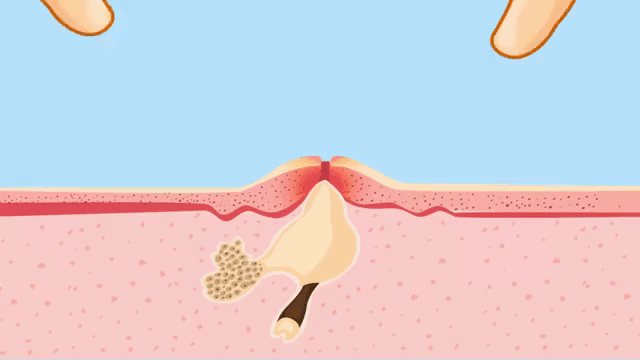
In general, such a procedure is quite complicated in terms of maintaining sterility, so it’s not worth taking risks - this is a last resort.
In addition to the described types of rash on a woman’s chin, medicine distinguishes two more:
- subcutaneous pimples - very painful, take a long time to grow/ripen, and when they are squeezed out, a scar forms;
- ulcers - indicate a bacterial infection of the subcutaneous layer or dermis, usually small and multiple.

Predisposing factors
One of the main predisposing reasons why acne appears after shaving is damage to the protective cover by the blade. As a result of such exposure, pathogenic bacteria penetrate into the wound, in particular staphylococci, which are to blame for the problem.
However, this factor does not always play a fundamental role, since a person may have a hypersensitive dermis that does not respond to care products.
So, acne occurs due to the following factors:
- a bad blade that damages the skin;
- poor quality care products;
- improper shaving technique;
- unsuitable shaving tools.
You can often see a pimple pop up after shaving in men who use the same razor for a long time. Over time, the blade becomes dull, which consequently complicates the hygienic process of caring for yourself. Such a tool will undoubtedly lead to a minimum of irritation of the dermis, and at most after it, numerous rashes will begin to appear, which, in addition to an aesthetic defect, also bring a physiological one, since they constantly itch and itch. This process is caused by pathogenic bacteria. A rash after shaving is not dangerous in itself, but some inflamed areas can develop into closed acne, which in turn may well provoke furunculosis or folliculitis.
Pimples after shaving occur for various reasons.
Oddly enough, regular shaving foam can also cause acne to appear on the face. The main reason is hypersensitivity to care products. That is, an allergic reaction can simply occur, provoking the development of pathogenic bacteria. If you notice that severe irritation has appeared after using a new foam, stop using it.
Caring balms, which are applied immediately after the process itself, can also provoke acne. They can also easily provoke irritation of the integument instead of calming. In addition, such products often lead to blackheads appearing after shaving. This is due to the fact that products with a too greasy consistency, instead of proper care, on the contrary, clog the sebaceous ducts, leading to the formation of plugs. They are the main culprits behind the appearance of acne.
However, tools and personal care products should not always be blamed for the occurrence of problems, since a person himself may use a razor or machine incorrectly, which leads to the appearance of an inflammatory process. Experts do not recommend shaving against hair growth, because this greatly injures and irritates the dermis.
Due to some physiological characteristics of the skin, a machine or razor is not suitable for everyone. Some representatives immediately experience irritation after dry shaving, but after using the machine, on the contrary, no deviations are observed.
Therefore, experiment to see which tool suits you best.
Choosing shaving and aftershave products
As for the products used before and after shaving, they can be both female and male. After all, women's products are no different from men's, except perhaps in aroma. You can use shaving lotions or foam. The only thing is to avoid products that contain menthol, alcohol or camphor. When these substances come into contact with freshly shaved skin, they cause severe irritation. And a rash after shaving your legs can appear solely for this reason.
Effective remedies to help get rid of shaving rash
If you get a rash after shaving your legs, you need to get rid of it. Moreover, you want to cure this rash as soon as possible - it hurts, and it doesn’t look aesthetically pleasing! You can get rid of a rash on your legs using pharmaceutical products or those you prepare yourself.
Pharmaceutical products that relieve irritation
The pharmaceutical drugs you need are those that contain cortisone
Important: you should not overuse creams with cortisone, as the skin gets used to this substance and after stopping the use of the cream, irritation will manifest itself even more. Therefore, products with cortisone should be used in extreme cases. Chlorhexidine will also help get rid of the rash - this remedy relieves irritation and prevents the appearance of pustules. Many people advise applying baby powder or talcum powder to the skin after shaving, which dries the skin and relieves redness. Another remedy is erythromycin ointment with an antibiotic. After shaving, you can also apply Boro Plus cream to your skin.
Home remedies for shaving rash
- To make a home remedy, you will need aspirin after shaving your legs and some glycerin! Grind two aspirin tablets into powder and mix with 2 tbsp. glycerin. Using a cotton swab, apply the resulting mixture to the inflamed areas of the skin and leave for 15 minutes. However, this procedure must be done immediately after shaving!
- After shaving, the skin can be treated with a roll-on deodorant. This product also has an antibacterial effect.
- Another effective remedy that will help cope with rashes after shaving is aloe juice. Aloe leaves need to be washed and dried, then break the leaf and lubricate the skin with the juice. This plant has good antimicrobial and anti-inflammatory properties and will prevent skin irritation after shaving.
How to choose a razor?
If you remove hair with a razor, then it must be expensive and very good. It is best to use a machine with a triple, or at least double, blade, which has special protective strips soaked, for example, in aloe juice. It is clear that shaving legs cannot be done with a dull razor. Otherwise, a rash will appear almost instantly after shaving your legs!
In general, the choice of razor largely depends on your skin type and the thickness of your hair. Therefore, to choose the most suitable shaving device, you need to experiment! Although, according to the women themselves, the most optimal for most women are “sophisticated” men’s machines.
Treatment of skin defects after shaving
Minor rashes, pustules, and cuts after shaving require proper treatment, otherwise there is a risk of acne spreading throughout the face. In addition to a cosmetic defect, they also cause noticeable physical discomfort - tightness, pain, pain, burning, itching constantly remind you of the problem.
Remedies for acne:
- Shaving foam or gel. For skin prone to irritation, you need to choose a bactericidal product, or one that contains silicone, aloe juice, witch hazel, and chamomile. It is forbidden to use products with a high alcohol content or with triclosan.
- Skin treatment after shaving. In addition to high-quality lotions and creams, which are applied to the face no earlier than 15 minutes later, when the skin has calmed down, you can use baby cream with calendula, chamomile, and natural almond oil.
- Micro-abrasions, cuts, and irritation are well healed by children's diaper rash remedies based on panthenol and miramistin (Bepanten, Desitin, Panthenol, Pantestin), as well as Sudocrem. If your skin is prone to oily skin, you can use panthenol in the form of powder.
- Washing with herbal decoction. This method will help those who have trouble finding a suitable aftershave product. For 500 g of boiling water, brew 3 tbsp. l dried chamomile or calendula flowers, leave for 30 minutes. The skin should be wiped with warm infusion (moisten a cotton swab in the broth) or make a compress - put gauze soaked in liquid and slightly wrung out on the face (for 5 minutes).
- Treatment with natural remedies: aloe and cucumber juice soothe the skin and help regenerate damaged areas of the epidermis, preventing the appearance of acne.
Sometimes the irritation does not go away for several days, and the skin condition worsens. Large abscesses, redness, and swelling may appear - this indicates infection in the lesions. This situation requires the intervention of a dermatologist or cosmetologist.
The main types and causes of skin rashes after shaving
There are two types of acne that appear shortly after shaving or waxing:
- red - as a result of an allergic reaction or local skin irritation;
- white (ulcers) - mean infection in small wounds, development of inflammation.
Common factors that cause acne to appear 12-36 hours after shaving include:
- mechanical damage to the skin (with a sharp blade it is easy to cut off a small inflammation hidden under regrown hairs; harmful bacteria enter the open wound and cause the development of a focus of inflammation);
- incorrect selection of shaving accessories and cosmetics;
- the use of dull (old) blades that are not able to completely cut off regrown stubble;
- incorrect shaving technique (too fast pace or excessive pressure on the razor).
Did you know that the most common mistake is dry shaving, without using water or special foam?
Unfortunately, many people do it without thinking about the harm they cause to their own skin. This hair removal is guaranteed to cause rashes, since the blades cause serious damage to the upper layers of the skin.

If you do not pay attention to the rash in time and continue to practice the “dry” shaving method, there is every chance of getting pyoderma, or purulent wounds.
It often happens to women that acne appears in the bikini area, while shaving their legs is painless and without negative consequences. Why is this happening? In the intimate area, the thickness of the skin is much less than on the hips and ankles, and its sensitivity is much higher. It is easy to injure such dermis.
In addition, it is possible to change the position of the hair follicles. When wearing tight-fitting clothes and tight underwear, small hairs easily “grow” into the skin, thereby causing redness and inflammation.
